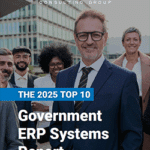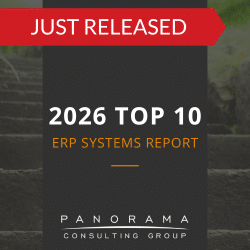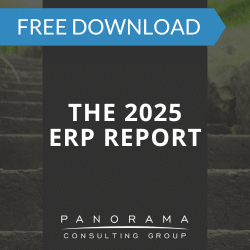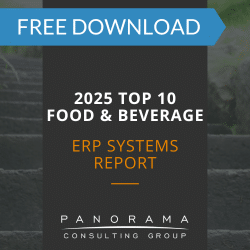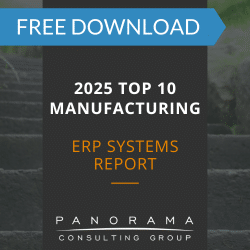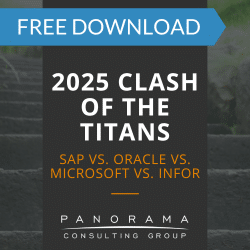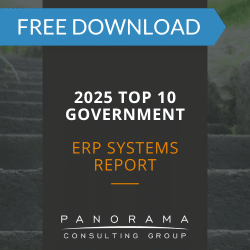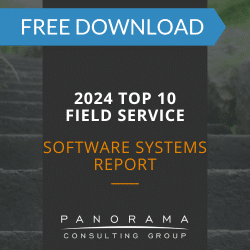Key Takeaways
- ERP user role definitions influence how people interact with business processes, data, and compliance controls across the enterprise.
- Deciding who owns role definitions in ERP software requires collaboration between IT, HR, and business units.
- HR data governance in ERP impacts how consistently job roles, access permissions, and approval workflows are structured and maintained.
During an ERP implementation, the question of who defines user roles—HR or IT—can quickly escalate into a tug-of-war that impacts everything from compliance to operational efficiency.
At first glance, ERP user role definitions may appear to be a purely technical exercise, but underneath the surface, they touch on issues of process ownership, data governance, and organizational change.
The stakes are high: poorly defined roles lead to audit risks, user resistance, and security gaps that cascade across the enterprise. Let’s talk about how organizations can define ERP user roles with clarity, resolve ownership conflicts, and implement scalable governance models.
The 2025 ERP Report
72.6% of respondents said they've already deployed AI at their organizations. Learn about AI adoption and other ERP trends by downloading our latest report.
ERP Role Definitions Are About People, Processes, and Data
A user role governs what transactions a person can initiate, what data they can view, and what systems they can influence. ERP user role definition is the exercise of aligning people with processes and the data they need to perform their responsibilities.
For example, a procurement analyst might require access to supplier records, purchase order workflows, and budget visibility—but should never be able to approve their own transactions.
In finance, a controller might need the ability to post journal entries but be restricted from changing underlying master data.
Defining ERP user roles is inseparable from defining business accountability. And this is where the ownership question becomes more complex.
Who Owns Role Definitions in ERP?
This is especially true in modern ERP environments, where user roles shape workflows, reporting hierarchies, and automation triggers. A poorly scoped role might prevent a plant manager from scheduling production runs or cause an order entry specialist to bypass pricing controls.
Leaders should ask:
- Who understands the job function? (often HR, but in many organizations, this insight resides with business process owners or functional leads)
- Who understands system architecture and security? (typically IT)
- Who owns the process the user is supporting? (often business units)
Each of these groups should have a seat at the table. The challenge is formalizing that collaboration through structured role governance.
Real-World Examples: When Role Ownership Breaks Down
Our work as ERP advisors has shown that unclear role governance shows up frequently as the root cause of operational and compliance challenges.
Case Study 1: Manufacturing Company Struggling with Manual Workarounds
During an assessment for a food manufacturing client, Panorama identified that system access had never been formally tied to process responsibilities. As a result, teams relied heavily on informal workarounds to execute approvals and validations outside the ERP environment.
With no defined process owners for financial controls or operational approvals, manual calculations became the norm.
The issue wasn’t just inefficiency—it created exposure in auditability and consistency since no one could confidently say who should be allowed to approve what.
Case Study 2: Healthcare Organization with Decentralized Access Control
In an assessment for a multi-entity healthcare provider, Panorama found that access management had become fragmented across HR, IT, and Finance. Each department provisioned users independently, leading to inconsistent role configurations across business units. System reporting was siloed, responsibilities were duplicated, and workflows frequently bypassed system approvals.
In both cases, Panorama’s recommendations centered on formalizing role ownership through centralized governance.
Until ownership is defined, efficiency and compliance will remain out of reach.
Best Practices for ERP Role Governance
To avoid confusion, role conflicts, and compliance failures, executives should establish a unified framework for defining and managing user roles. Below are several best practices for ensuring clarity and consistency:
1. Establish a Role Governance Board
Create a cross-functional group—often led by IT and HR jointly—with representatives from key business functions. This board should define the methodology for ERP user role definitions, approve role creation and changes, and oversee periodic audits.
This approach ensures that role definitions balance system constraints with operational needs. It also creates a documented trail of decision-making that supports compliance and audit readiness.
2. Align Role Definitions with Business Processes
ERP roles should align directly with process responsibilities.
Use swimlane diagrams and process maps to identify handoffs, data touchpoints, and decision rights. Then, structure roles around those insights.
This process-driven approach reduces the risk of over-permissioning or duplicate access paths. It also helps surface conflicts where responsibilities overlap across functions.
For example, in an order-to-cash process, Sales, Finance, and Operations may all own different steps but require visibility into overlapping data. In these cases, role design should be preceded by workshops that define handoffs, accountability boundaries, and exception handling rules.
3. Integrate HR Data Governance with ERP Role Design
The maturity of your HR data governance in ERP directly affects how well you can manage user roles. If job titles, reporting structures, and employee classifications are inconsistent across systems, role assignments will be equally fragmented.
Organizations should invest in cleaning and standardizing HR master data before and during ERP role configuration. This includes integrating the ERP system with HRIS platforms and creating clear rules for data ownership and change control.
4. Apply Segregation of Duties (SoD) Early
One of the most overlooked aspects of role definition is the enforcement of SoD policies.
Rather than layering SoD on top of existing roles as an afterthought, design roles with SoD in mind from the outset.
For example, our ERP consultants often advise clients that no single role should allow a user to both create and approve supplier payments.
By embedding SoD logic early, organizations reduce the need for manual overrides or workflow exceptions later.
5. Treat Role Definitions as a Living Asset
ERP user roles should evolve alongside the business. As functions expand and processes change, role definitions need to be updated—and those updates must be governed.
We recommend quarterly reviews for high-risk roles and an annual refresh cycle for all role definitions. This should include reconciling inactive users, validating usage patterns, and capturing changes in job responsibilities.
6. Use Role-Mining and Access Analytics to Scale Governance
As ERP environments evolve, manually managing roles quickly becomes unsustainable.
Role-mining tools and access analytics platforms can help organizations identify actual usage patterns, eliminate redundant permissions, and surface SoD violations early. These technologies also support compliance by automating audit trails and flagging anomalies.
7. Remember That Roles Are Only as Strong as Their Adoption
In many ERP implementations, resistance comes from employees who don’t agree with how their authority or responsibilities have been redefined.
Role ownership must be reinforced through:
- Clear communication of why access boundaries exist
- Training that explains not just how to use the system, but why certain actions are restricted
- Manager-level accountability for approving and validating access requests
In our ERP advisory experience, pushback on role enforcement is often a symptom of deeper process misalignment and unclear accountability.
Learn More About HR Data Governance in ERP
Organizations that approach role ownership with a collaborative, cross-functional lens will see fewer compliance issues, faster user adoption, and more scalable ERP platforms.
Those who defer entirely to one department—HR or IT—risk building fragile systems that fail under pressure.
Our ERP implementation consultants can help you ensure that ERP user role definitions are aligned with workforce governance and business process accountability. Contact us below for an ERP consultation.


